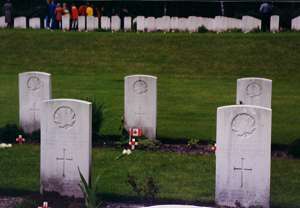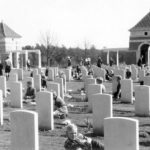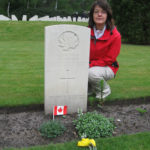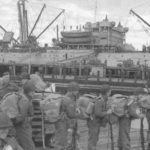
In 1998 the gratitude of the Dutch still alive in Holten. Over fifty years after the war is over the people still remember the Canadians who liberated their country. Celebrations and remembrance ceremonies still occur at the Holten Cemetery.
The photos on this page were submitted by Alex and Marca van Haren of Beneden Leeuwen, The Netherlands. They visited the ceremony on the 1st of May, 1998 and were kind enough to take some photos of Loren’s gravesite for Loren’s relatives in Canada. Many thanks go out to them for giving us these memories.
The Story of Holten Cemetery
Even until Autumn 1945 one could find crosses scattered all over the country in the Eastern and Northern parts of the Netherlands, marking the places where soldiers had been killed and buried. The crosses stood in gardens, pastures or just at the side of the road, in an area that has been cleared of five years of oppression. For that reason the soldiers had given the greatest sacrifice, their lives.
One day, while passing Holten, it occurred to Lt. General G.G. Simonds, commander of the 2nd Canadian Army that the Holterberg area might be a suitable place for a Canadian War Cemetery. The soldiers who were killed in the spring of 1945 during the liberation of the Eastern and Northern parts of the Netherlands and the taking of the North German town Oldenburg could be buried here.
Some officers made contact with Mr. W.H. Enklaar mayor of Holten at the time. Mr. Enklaar immediately did everything possible to realize a cemetery. In a later stage negotiations were carried on by the Ministry of War. The result was that the grounds were given to the Canadian Government. It is still Canadian territory.
The Cemetery was constructed and carried out by Canadian soldiers who were waiting for their repatriation. They flattened and terraced the site. The first people buried were all Canadian soldiers, killed in the area of Holten. Their graves are in the first plot of the new cemetery, left of the entrance. Nearly 1400 fallen comrades were to follow. Until summer 1946 the bodies of Canadians killed in the Netherlands and Northern Germany were buried here.
Afterwards the planned area, 14 acres, turned out to be too large, so the front part was laid out as a beautiful heather garden. Until 1970 both cemetery and garden were kept by Mr. Reeves, an Englishman. He served in the Royal Hampshire Regiment. Now the work is done by Mr. Krieger. Among the rustling pines of the Holterberg lies the cemetery quietly with its hundreds of graves. Most of the men here were volunteers who gave their lives for our freedom.
Every year on May 4th a service of remembrance is held on the cemetery. Veterans staying in Holten or elsewhere in the country attend the ceremony. School children of the highest groups of the Primary School participate in the ceremony. Every 5 years Dutch and Canadian authorities are also present.

For some years the local school children put candles on the graves of the Canadian soldiers buried on the cemetery on Christmas Eve. This idea was began by Mrs. Van Dam, born in Finland and living in Holten. This is a custom introduced from her native country. More than 1,500 candle lights give the cemetery an impressive look.
The 1355 Canadians who are buried in Holten nearly all died during the last stages of the war in Holland and during the advance of the Canadian 2nd Corps into Germany.
Holten Cemetery – 1998
Here is a good view of Loren’s gravesite (in the center of the photo). On each grave you can see a Canadian flag, a wooden cross and a bouquet of flowers which have been placed on the graves by Dutch school children. The crosses have been made in Canada through the generosity of Judy Stinson and Bill Webster of St. Thomas Ontario.
Here is a modern day photo of Loren’s grave. You will quickly notice how beautifully cared for the site is. It is wonderful how the Dutch people have cared for these lost souls who never had the chance to return home.
The inscription:
H.22396 PRIVATE
L.N. NELSON
LINCOLN AND WELLAND REGIMENT
10TH APRIL 1945 AGE 19
THE LORD IS MY SHEPHERD
PSALM XXIII.I





